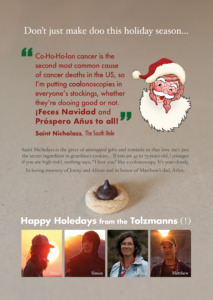By Alexa Kanbergs, MD-ScM, MS
What is IGNITE-TX?
Have you been diagnosed with Lynch Syndrome or a BRCA1 or BRCA2 genetic mutation? Do you have family members who have not yet undergone genetic testing? If yes, then this study may be for you! The IGNITE-TX study explores ways to increase genetic testing for family members of those diagnosed with Lynch Syndrome or a BRCA1 or BRCA2 genetic mutation. This is also known as cascade genetic testing.
What the Study Involves
Individuals eligible for the study will be granted access to the IGNITE-TX website. The website contains information about their genetic mutation and how to share information with family members. Participants and their family members will be placed at random into four groups:
- Group 1: Standard of care, which is receiving a letter with information on their specific hereditary cancer syndrome that they can share with their relatives
- Group 2: Free genetic counseling and testing
- Group 3: The IGNITE-TX intervention, which gives family members access to the website and education modules as well as access to a study navigator
- Group 4: The IGNITE-TX intervention and free genetic counseling and testing.
All participants (including family members enrolled in the study) will be asked to complete a baseline survey and then follow-up surveys at 6 and 12 months. Participants will receive a $10 gift card after completion of each survey.
Why Should I Enroll?
There are good reasons to join the IGNITE-TX Study. First, you get to help others. By joining, you can help test your family members, and it also helps us learn better ways to conduct genetic testing for people whose family has a history of cancer. Additionally, everyone who takes part in the study will be compensated for their time.
How Do I Know if I am Eligible to Enroll?
You are eligible to participate in this trial if:
- You are 18 years of age or older
- You or your family member has a positive genetic test result for the BRCA1/BRCA2 mutation or Lynch syndrome (MLH1, MSH2, MSH6, PMS2, EPCAM mutation)
- You have an email address and/or a U.S. cell phone number
- You speak English or Spanish
You are not eligible to participate if:
- You do not have any relatives
- You do not have one of the genetic conditions listed above or only have been told you have a variant of uncertain significance
Study Locations
We are targeting enrolling patients throughout the U.S.
Study Contact Information
J. Alejandro Rauh-Hain, PI
Heidy Bosch Study Coordinator
Study specific contact information: [email protected], Phone: 713 792 9155
Clinicaltrials.gov identifier:
NCT05677048 (https://clinicaltrials.gov/show/NCT05677048)
Alexa Kanbergs, MD-ScM, MS, is a Gynecologic Oncology Fellow, MD Anderson Cancer Center.
Photo credit: Rajiv Perera on Unsplash




